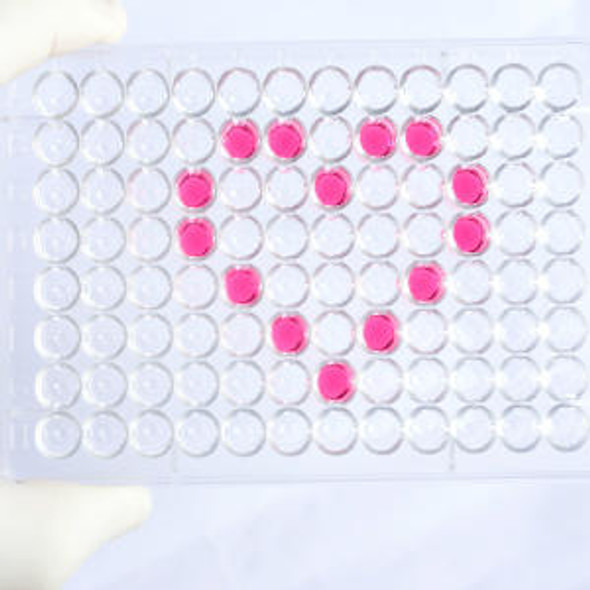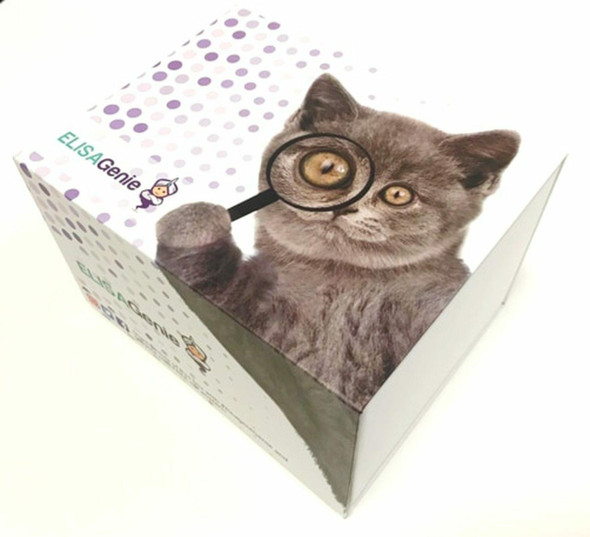Human Cell Biology ELISA Kits 5
Human ACP5 (Tartrate Resistant Acid Phosphatase 5) CLIA Kit (HUES00879)
- SKU:
- HUES00879
- Product Type:
- ELISA Kit
- ELISA Type:
- CLIA Kit
- Size:
- 96 Assays
- Sensitivity:
- 0.09ng/mL
- Range:
- 0.16-10ng/mL
- ELISA Type:
- Sandwich
- Synonyms:
- TRAP, SPENCDI
- Reactivity:
- Human
- Sample Type:
- Serum, plasma and other biological fluids
- Research Area:
- Cell Biology
Description
| Assay type: | Sandwich |
| Format: | 96T |
| Assay time: | 4.5h |
| Reactivity: | Human |
| Detection method: | Chemiluminescence |
| Detection range: | 0.16-10 ng/mL |
| Sensitivity: | 0.09 ng/mL |
| Sample volume: | 100µL |
| Sample type: | Serum, plasma and other biological fluids |
| Repeatability: | CV < 15% |
| Specificity: | This kit recognizes Human ACP5 in samples. No significant cross-reactivity or interference between Human ACP5 and analogues was observed. |
This kit uses Sandwich-CLIA as the method. The micro CLIA plate provided in this kit has been pre-coated with an antibody specific to Human ACP5. Standards or samples are added to the appropriate micro CLIA plate wells and combined with the specific antibody. Then a biotinylated detection antibody specific for Human ACP5 and Avidin-Horseradish Peroxidase (HRP) conjugate are added to each micro plate well successively and incubated. Free components are washed away. The substrate solution is added to each well. Only those wells that contain Human ACP5, biotinylated detection antibody and Avidin-HRP conjugate will appear fluorescence. The Relative light unit (RLU) value is measured spectrophotometrically by the Chemiluminescence immunoassay analyzer. The RLU value is positively associated with the concentration of Human ACP5. The concentration of Human ACP5 in the samples can be calculated by comparing the RLU of the samples to the standard curve.
| UniProt Protein Function: | ACP5: Involved in osteopontin/bone sialoprotein dephosphorylation. Its expression seems to increase in certain pathological states such as Gaucher and Hodgkin diseases, the hairy cell, the B-cell, and the T-cell leukemias. Defects in ACP5 are the cause of spondyloenchondrodysplasia with immune dysregulation (SPENCDI). A disease characterized by vertebral and metaphyseal dysplasia, spasticity with cerebral calcifications, and strong predisposition to autoimmune diseases. The skeletal dysplasia is characterized by radiolucent and irregular spondylar and metaphyseal lesions that represent islands of chondroid tissue within bone. ACP5 inactivating mutations result in a functional excess of phosphorylated osteopontin causing deregulation of osteopontin signaling and consequential autoimmune disease. Belongs to the metallophosphoesterase superfamily. Purple acid phosphatase family. |
| UniProt Protein Details: | Protein type:Motility/polarity/chemotaxis; Phosphatase; Cofactor and Vitamin Metabolism - riboflavin; EC 3. 1. 3. 2 Chromosomal Location of Human Ortholog: 19p13. 2 Cellular Component: lysosome; integral to membrane; cytosol Molecular Function:acid phosphatase activity; ferric iron binding; ferrous iron binding Biological Process: riboflavin metabolic process; negative regulation of interleukin-12 production; defense response to Gram-positive bacterium; vitamin metabolic process; dephosphorylation; response to cytokine stimulus; negative regulation of nitric oxide biosynthetic process; negative regulation of inflammatory response; response to lipopolysaccharide; negative regulation of interleukin-1 beta production; negative regulation of tumor necrosis factor production; negative regulation of superoxide release; water-soluble vitamin metabolic process; bone resorption Disease: Spondyloenchondrodysplasia With Immune Dysregulation |
| NCBI Summary: | This gene encodes an iron containing glycoprotein which catalyzes the conversion of orthophosphoric monoester to alcohol and orthophosphate. It is the most basic of the acid phosphatases and is the only form not inhibited by L(+)-tartrate. [provided by RefSeq, Aug 2008] |
| UniProt Code: | P13686 |
| NCBI GenInfo Identifier: | 56757583 |
| NCBI Gene ID: | 54 |
| NCBI Accession: | P13686. 3 |
| UniProt Secondary Accession: | P13686,Q2TAB1, Q6IAS6, Q9UCJ5, Q9UCJ6, Q9UCJ7, A8K3V2 |
| UniProt Related Accession: | P13686 |
| Molecular Weight: | 325 |
| NCBI Full Name: | Tartrate-resistant acid phosphatase type 5 |
| NCBI Synonym Full Names: | acid phosphatase 5, tartrate resistant |
| NCBI Official Symbol: | ACP5 |
| NCBI Official Synonym Symbols: | TRAP; SPENCDI |
| NCBI Protein Information: | tartrate-resistant acid phosphatase type 5; TrATPase; tartrate-resistant acid ATPase |
| UniProt Protein Name: | Tartrate-resistant acid phosphatase type 5 |
| UniProt Synonym Protein Names: | Tartrate-resistant acid ATPase; TrATPase; Type 5 acid phosphatase |
| Protein Family: | Acyl carrier protein |
| UniProt Gene Name: | ACP5 |
| UniProt Entry Name: | PPA5_HUMAN |
As the RLU values of the standard curve may vary according to the conditions of the actual assay performance (e. g. operator, pipetting technique, washing technique or temperature effects), the operator should establish a standard curve for each test. Typical standard curve and data is provided below for reference only.
| Concentration (ng/mL) | RLU | Average | Corrected |
| 10 | 30731 34211 | 32471 | 32447 |
| 5 | 14762 16178 | 15470 | 15446 |
| 2.5 | 8093 6913 | 7503 | 7479 |
| 1.25 | 3435 3871 | 3653 | 3629 |
| 0.63 | 1860 1662 | 1761 | 1737 |
| 0.31 | 874 774 | 824 | 800 |
| 0.16 | 344 370 | 357 | 333 |
| 0 | 23 25 | 24 | -- |
Precision
Intra-assay Precision (Precision within an assay): 3 samples with low, mid range and high level Human ACP5 were tested 20 times on one plate, respectively.
Inter-assay Precision (Precision between assays): 3 samples with low, mid range and high level Human ACP5 were tested on 3 different plates, 20 replicates in each plate.
| Intra-assay Precision | Inter-assay Precision | |||||
| Sample | 1 | 2 | 3 | 1 | 2 | 3 |
| n | 20 | 20 | 20 | 20 | 20 | 20 |
| Mean (ng/mL) | 0.55 | 0.91 | 4.72 | 0.56 | 0.97 | 4.61 |
| Standard deviation | 0.07 | 0.10 | 0.51 | 0.06 | 0.11 | 0.39 |
| C V (%) | 12.73 | 10.99 | 10.81 | 10.71 | 11.34 | 8.46 |
Recovery
The recovery of Human ACP5 spiked at three different levels in samples throughout the range of the assay was evaluated in various matrices.
| Sample Type | Range (%) | Average Recovery (%) |
| Serum (n=5) | 90-106 | 98 |
| EDTA plasma (n=5) | 90-105 | 96 |
| Cell culture media (n=5) | 89-102 | 97 |
Linearity
Samples were spiked with high concentrations of Human ACP5 and diluted with Reference Standard & Sample Diluent to produce samples with values within the range of the assay.
| Serum (n=5) | EDTA plasma (n=5) | Cell culture media (n=5) | ||
| 1:2 | Range (%) | 90-101 | 100-113 | 89-103 |
| Average (%) | 96 | 106 | 95 | |
| 1:4 | Range (%) | 99-115 | 101-116 | 94-105 |
| Average (%) | 106 | 107 | 99 | |
| 1:8 | Range (%) | 88-102 | 90-105 | 96-108 |
| Average (%) | 95 | 96 | 103 | |
| 1:16 | Range (%) | 100-113 | 88-101 | 91-102 |
| Average (%) | 106 | 94 | 96 |
An unopened kit can be stored at 4°C for 1 month. If the kit is not used within 1 month, store the items separately according to the following conditions once the kit is received.
| Item | Specifications | Storage |
| Micro CLIA Plate(Dismountable) | 8 wells ×12 strips | -20°C, 6 months |
| Reference Standard | 2 vials | |
| Concentrated Biotinylated Detection Ab (100×) | 1 vial, 120 µL | |
| Concentrated HRP Conjugate (100×) | 1 vial, 120 µL | -20°C(shading light), 6 months |
| Reference Standard & Sample Diluent | 1 vial, 20 mL | 4°C, 6 months |
| Biotinylated Detection Ab Diluent | 1 vial, 14 mL | |
| HRP Conjugate Diluent | 1 vial, 14 mL | |
| Concentrated Wash Buffer (25×) | 1 vial, 30 mL | |
| Substrate Reagent A | 1 vial, 5 mL | 4°C (shading light) |
| Substrate Reagent B | 1 vial, 5 mL | 4°C (shading light) |
| Plate Sealer | 5 pieces | |
| Product Description | 1 copy | |
| Certificate of Analysis | 1 copy |
- Set standard, test sample and control (zero) wells on the pre-coated plate and record theirpositions. It is recommended to measure each standard and sample in duplicate. Note: addall solutions to the bottom of the plate wells while avoiding contact with the well walls. Ensuresolutions do not foam when adding to the wells.
- Aliquot 100µl of standard solutions into the standard wells.
- Add 100µl of Sample / Standard dilution buffer into the control (zero) well.
- Add 100µl of properly diluted sample (serum, plasma, tissue homogenates and otherbiological fluids. ) into test sample wells.
- Cover the plate with the sealer provided in the kit and incubate for 90 min at 37°C.
- Aspirate the liquid from each well, do not wash. Immediately add 100µL of BiotinylatedDetection Ab working solution to each well. Cover the plate with a plate seal and gently mix. Incubate for 1 hour at 37°C.
- Aspirate or decant the solution from the plate and add 350µL of wash buffer to each welland incubate for 1-2 minutes at room temperature. Aspirate the solution from each well andclap the plate on absorbent filter paper to dry. Repeat this process 3 times. Note: a microplatewasher can be used in this step and other wash steps.
- Add 100µL of HRP Conjugate working solution to each well. Cover with a plate seal andincubate for 30 min at 37°C.
- Aspirate or decant the solution from each well. Repeat the wash process for five times asconducted in step 7.
- Add 100µL of Substrate mixture solution to each well. Cover with a new plate seal andincubate for no more than 5 min at 37°C. Protect the plate from light.
- Determine the RLU value of each well immediately.






